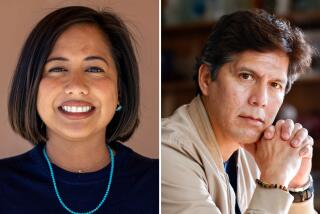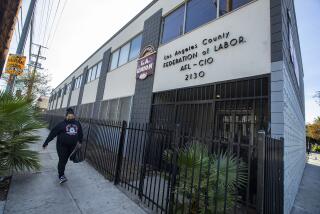Column: A female mayor denounces the harassment she receives. Hours later, a man is arrested at her office
- Share via
If you are a woman who is so bold as to inhabit a vaguely public stage, chances are high that you will be called a lot of things that can’t be printed in a family newspaper. And then some.
It’s a truism that unfortunately appears to transcend industry or geography. Exist in public, and eventually an online mob will nitpick your looks, rate your sexual desirability in relation to your ability to do your job, and probably make threats vague and specific — regardless of whether you’re a female journalist, the founder of an indie game studio or trying to run a small city in the Central Coast region of California.
San Luis Obispo Mayor Heidi Harmon was fed up when she finally took to Facebook last Monday morning to call out the constant harassment she received.
“The amount of cruelty, rudeness, threats, sexism, stalking, body shaming, rude/threatening comments towards my children, etc. I receive are unbelievable,” she wrote. Harmon, who was elected in 2016, felt torn between her ability to use social media for constructive good and the toxic online sludge that often came her way there.
A few hours after Harmon published her Facebook post, a man was arrested at City Hall for trying to force his way into the mayor’s office. The San Luis Obispo Tribune reported that the man — who has “a strange romantic fixation on the mayor” — knocked a city staffer to the ground before being restrained by the city manager.
But Harmon, who was fortunately not at City Hall at the time of the incident, is far from alone in her experiences.
A recent study published in the academic journal State and Local Government Review found that mayors — women and men — face greater levels of physical violence and psychological abuse than those in the general U.S. workforce, with social media being the most common channel for that abuse.
Female mayors were not only much more likely to face some form of violence or abuse, but they were also more likely to experience abuse of a sexualized nature.
“Women are facing more of this kind of abuse and violence, and more types of it,” Sue Thomas, a research scientist and co-author of the study, told me.
The abuse and violence that female mayors face are likely heightened by the executive nature of their job. When Thomas expanded her research to include state senators across the U.S., she found that legislators faced the same kind of psychological abuse and physical violence as mayors did. But that study, which is not yet published, showed that while gender differences were still present, they were not as pronounced.
The results were unsurprising to her: Mayors have more focus on them and tend to be seen as more responsible for the actions taken by a city. In a legislative position, you’re one of many.
But among state senators, female committee chairs experience more violence than women who are not committee chairs. “Meaning, as you hold more power and responsibility, the more types of abuse and violence you may face,” Thomas explained.
The thread that links the two studies, Thomas said, is the extent to which an individual holds responsibility or is seen as having power.
Mayor Harmon also used the word “power” when she described an incident early in her mayorship. At the time, she was introducing a male public figure whose work she admired at a local event.
Power, in her estimation, was the thing that man was trying to take away from her when he grabbed the microphone and said, “Wow, how great it must be to live in a town with a kissable mayor” after she stepped off the stage.
His words were “theoretically complimentary,” but they reduced her to an object. In her view, the comment didn’t just disempower her, but also every other woman in the theater that night. All of whom were instantly reminded that they could win elections, lead cities and still remain “essentially objects, as far as the men are concerned.”
Harmon was careful to draw a distinction between “differing opinions,” which she welcomes, and “abuse,” most of which appears online.
Speaking over the phone, Harmon told me she was particularly troubled to see an Instagram comment appear after last Monday’s incident at City Hall saying she “deserved to be sexually assaulted.”
“It’s completely devastating to see that even in the light of serious threats against me that people would still comment in that way,” she said, referencing the arrest of the man at her office.
Some of the abuse she receives is explicitly gendered and, at times, even graphically sexual — like a local anonymous Instagram account that recently reposted a photo Harmon had shared of herself with a bloodied knee from a bike accident with added text suggesting that she’d received the injury while engaged in a sex act with the governor.
But in Harmon’s view, even many of the non-explicitly gendered attacks — like the people who call her “trailer trash” because she lives in a mobile home, or those who mock her because she worked as a house cleaner while raising her now grown children — are still “rooted in misogyny.”
Much of it comes via social media, but Harmon said she also often experienced comments from men — her constituents — that were of an “inappropriately sexual nature, or even just focused on my looks as a general category” while out in public, doing her job.
In those instances, she often feels torn about how to proceed. How do you call someone out for inappropriate comments while also trying to build consensus and focus on the meaningful work you’re trying to accomplish for your city? “It puts me in a really tough position,” she said.
Harmon said that she had replayed the “kissable mayor” incident over in her head many times since it happened, especially in light of recent events. Each time, she would wonder what she would do differently had it happened now.
“I think I would have walked back on stage, asked him nicely for the microphone back and just named it,” she mused. She would tell him why it wasn’t OK, and why it was a misogynist comment, she said.
“I am not here to be kissed,” she continued. “I’m here to lead this city and to create policy for the people in this community.”
More to Read
Sign up for Essential California
The most important California stories and recommendations in your inbox every morning.
You may occasionally receive promotional content from the Los Angeles Times.











